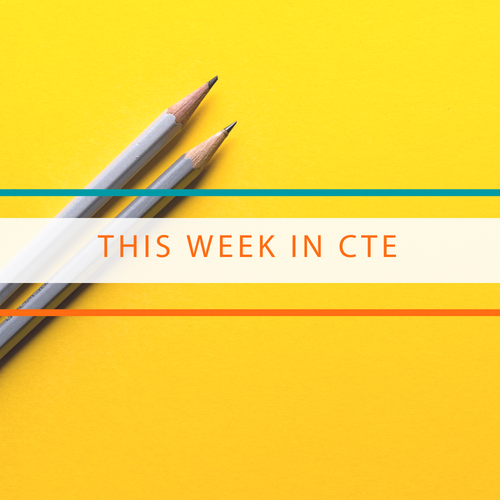 Democratic lawmakers in Congress have made progress on a domestic spending package aimed at investing in the nation’s human capital infrastructure, including Career Technical Education (CTE). Meanwhile, a House subcommittee recently examined how states and school districts are making use of education-related pandemic aid while the U.S. Department of Education (ED) issued new nonregulatory guidance, announced changes to civil rights data collections and more.
Democratic lawmakers in Congress have made progress on a domestic spending package aimed at investing in the nation’s human capital infrastructure, including Career Technical Education (CTE). Meanwhile, a House subcommittee recently examined how states and school districts are making use of education-related pandemic aid while the U.S. Department of Education (ED) issued new nonregulatory guidance, announced changes to civil rights data collections and more.
House Passes Build Back Better Act (BBBA)
After months of intense debate and negotiations, House Democrats successfully passed the Build Back Better Act (H.R. 5376) on November 19. The passage of this legislation is an important next step in Congressional Democrats’ ongoing efforts to pass a wide-ranging domestic spending package to complement the recently passed and enacted Infrastructure Investment and Jobs Act (IIJA). While the IIJA was passed via the regular legislative process, Congressional Democrats are making use of the budget reconciliation process which allows certain legislation, like the BBBA, to be passed by simple majorities in both Chambers of Congress (thereby avoiding a likely Republican filibuster of the legislation).
In the lead up to the BBBA’s passage in the House, the Congressional Budget Office released an official “scoring” of the legislation, including for the bill’s education and workforce development provisions. This was a key point of contention for some House Democrats who wanted this score prior to a formal vote. Following the release of this score, the BBBA was passed narrowly along party lines by a margin of 220-213. The BBBA now heads to the Senate where the lawmakers in the upper chamber are widely expected to make additional changes to the legislation in the coming weeks ahead.
As shared previously, this version of the BBBA would provide $600 million for the Strengthening Career and Technical Education for the 21st Century Act’s (Perkins V) basic state grant formula program and $100 million for the law’s Innovation and Modernization competitive grant program. If enacted, the legislation would address a host of Advance CTE’s policy priorities and would also provide $5 billion for Community College and Industry Partnership grants while also ensuring that certain Area Technical Centers are eligible to apply for this funding. As the BBBA works its way further through the legislative process, Advance CTE will continue to advocate for these important investments as part of a final package which is widely expected to be complete by the end of the year.
House Subcommittee Examine Pandemic Aid Spending
On November 17 the House Education and Labor’s Subcommittee on Early Childhood, Elementary, and Secondary Education and its Subcommittee on Higher Education and Workforce Investment Subcommittee held a joint hearing titled “Examining the Implementation of COVID-19 Education Funds.” ED’s second highest ranking official, Deputy Secretary Cindy Marten, along with James Kvaal, ED’s top official for postsecondary education, provided testimony and answered questions as part of this hearing. The purpose of the hearing was to scrutinize state, district and institutions’ use of over $160 billion in collective pandemic-related funding provided since March 2020 to help the nation’s educational systems respond to and recover from the public health crisis.
The nearly four hour hearing explored a wide range of topics including ED’s ongoing efforts to monitor and oversee how these funds are being used by states, school districts and postsecondary institutions. In addition, lawmakers expressed a strong desire to ensure that this monitoring and oversight process ensures these funds are being spent in ways Congress intended. Relatedly, lawmakers also discussed efforts to develop reliable measures of student performance to more accurately assess the impact of programs and initiatives being funded with these pandemic relief resources. An archived webcast of the hearing, including witness testimony, can be found here.
ED Issues New Guidance Related to Student Transportation
This month, ED published new guidance related to the use of pandemic aid dollars for student transportation. The guidance, in the form of a Frequently Asked Questions (FAQ), provides answers to several questions related to the use of Elementary and Secondary School Emergency Relief (ESSER) and the Governor’s Emergency Education Relief (GEER) funding to provide transportation services to eligible students. Of note for the CTE community, this guidance affirms that school districts are permitted to use these funds, in certain circumstances, to provide transportation for students participating in after-school learning and enrichment programs. The full guidance can be found here.
MOU Signed to Expand Apprenticeship Programs
U.S. Secretary of Education Miguel Cardona, U.S. Secretary of Labor Marty Walsh, Deputy Secretary of Commerce Don Graves and Switzerland’s President Guy Parmelin signed a memorandum of understanding (MOU) as part of a series of events and announcements marking the nation’s 7th annual National Apprenticeship Week (NAW). The MOU will expand and make wider use of apprenticeships among Swiss companies operating in the United States. More information on the announcement can be found here.
ED Soliciting Feedback Regarding Civil Rights Data Collection
On November 18, ED’s Office for Civil Rights (OCR) announced that it has submitted to the Federal Register for public comment a proposed Civil Rights Data Collection (CRDC) Information Collection Request package for the 2021–22 school year. OCR plans to introduce new data categories by proposing the following data which were informed by listening sessions with stakeholders:
- The addition of COVID-19 (coronavirus) data elements to learn the extent to which schools are offering remote and/or in-person instruction to students during the school year;
- Revisions to restraint and seclusion definitions;
- The restoration and expansion of data about preschool students and teachers, including data elements regarding preschool students with disabilities who receive special education and related services and those who are English Learners; the extent to which schools have teachers with one or two years of experience; and teacher certification status; and
- The addition of a nonbinary option to male/female data categories for those schools and districts that already collect that data, to ensure the CRDC captures accurate and inclusive information about all student identities and student experiences, where the data are available.
Comments regarding these proposed changes to the CRDC information collection are due by January 18, 2022. The full announcement, including the portal to submit input, can be found here.
Odds & Ends
- ED approved Puerto Rico’s plan for using $990 million in American Rescue Plan (ARP) funding on November 18 to support K-12 schools and students. More information about the plan is located here.
- President Biden announced plans to nominate Glenna Gallo to serve as Assistant Secretary for Special Education and Rehabilitative Services. Ms. Gallo currently serves as the Assistant Superintendent of Special Education for the Washington state Office of Superintendent of Public Instruction.
Steve Voytek, Policy Advisor


 Our new career preparation ecosystem, designed under
Our new career preparation ecosystem, designed under  Developed with input from nearly 200 national, state and local education and workforce development leaders and supported by 40 national organizations,
Developed with input from nearly 200 national, state and local education and workforce development leaders and supported by 40 national organizations,  This event also introduced Opportunity America’s report,
This event also introduced Opportunity America’s report,